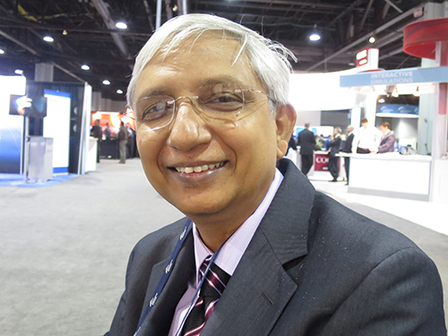
Can the industry be persuaded to provide previous-generation products that would otherwise be incinerated, to people in the developing world who cannot otherwise afford them? Mathew Cherian, director, Interventional Radiology, Kovai Medical Centre and Hospital Ltd, Coimbatore, India, and past president of the Indian Society of Vascular and Interventional Radiology, makes the case for expanding the availability of the benefits of interventional radiology procedures to a vast population that is unable to pay for the high cost of hardware.
Cherian spoke to Interventional News at the Society of Interventional Radiology’s annual scientific meeting in Atlanta, USA.
“In India, very often, we are unable to offer this absolutely phenomenal form of treatment [interventional radiology] to the most deserving. Imagine the situation of a labourer who earns about US$10 a day who requires an angioplasty. If I can perform this procedure for him, he can return to work after 48 hours and continue to earn a daily wage for the subsistence of his family. The major problem is that this labourer cannot afford an interventional radiology solution because the cost of hardware is so high,” Cherian said.
The big barrier to allowing interventional radiology to grow and percolate to the level it should, is finally the lack of availability to a large population who cannot afford it, he maintains.
Cherian has been trying to persuade the medical device industry that they should provide older versions of medical devices that are currently discarded or destroyed, to people in the developing world, at a fraction of their original price.
“I would like to use the example of ruptured aneurysms in the brain. We see that there is a next-generation of endovascular coils that comes up every two years or so .The price of each of these coils is close to US$700. An average person usually requires five to six coils, a balloon, and a guiding catheter for the procedure to be performed, so that the total cost of hardware alone ranges from US$3,000 to 5,000. Chatting with the industry, I have learned that older iterations of devices are simply destroyed. This leads me to the question: why cannot these older iterations of devices be simply given to people who cannot afford anything else, at a fraction of the price? Like the saying [commonly attributed, but with little credibility, to Marie Antoinette during the French Revolution], the industry is forcing people in the developing world to eat “cake” [the newest iterations of devices] when many cannot afford even “bread” [older generation devices].
“I am told that this outlined approach is not a good business model. However, in my view, this cluster of patients would not afford anything else, anyway. So, if these older iterations of devices were to be given away, at say 25% of the cost price, then the company would benefit and so would a vast population who cannot afford interventional radiology treatment. This same scenario applies to other devices such as stents, stent grafts, and a whole lot of other devices.”
Re-sterilisation
Adds Cherian, “When certain medical products have expired, quite often, the expiry is on the sterilisation and not regarding the integrity of the product itself. If there could be a certifiable method of sterilising an expired product, this could be another avenue by which the company can provide products that would otherwise be incinerated to people who cannot meet their expense otherwise. These avenues could transform the way interventional radiology treatments are made available in developing countries.”
It is like buying an older model car
“To illustrate, in the automobile industry, a car salesman does not maintain that older models of cars are going to be discarded or destroyed. They either make the prices for these attractive, or they have a scheme by which they can be sold. In India, even low to moderate income individuals buy second hand cars or older models,” adds Cherian.













